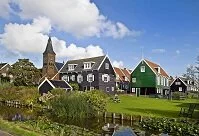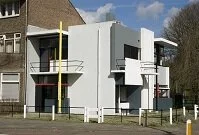
Village
Despite the vast number of examples of Gothic architecture in nearby France and England, the Netherlands didn't erect many buildings in the style, nor are there many buildings in the Renaissance style. The New Church (or Nieuwe Kerk; 1300s) in Delft, the Old Church (or Oude Kerk; 1200-1300s) in Amsterdam, and the Cathedral Church of St. John (or Sint-Janskathedraal; 1200-1300s) in North Brabant are the best examples of the Gothic style in the country, while the Old City Hall (1565) in The Hague is the perhaps the best example of Renaissance architecture in the country.
The Netherlands truly came to power in the 1600 and 1700s and at this time the Baroque style was popular, so much of the country's architecture is in this style, particularly in the city of Amsterdam. Amsterdam's Royal Palace (1648), the Huis ten Bosch (1645) in The Hague, and the Town Hall (1650s) in Maastricht are some of the more impressive buildings from this prosperous time period.

Rietveld Schroderhuis
The Netherlands', and in particular, Amsterdam's prosperity continued through the 1800s as a number of neo-Gothic churches were built, but the Art Nouveau style of the late 1800s and early 1900s along with other styles in the 1900s proved more popular. The Rietveld Schroder House (1924) in Utrecht is a striking example of modernist architecture and one of the most well-known buildings from the 1900s in the Netherlands.
For a good overview of Dutch architecture, the cities of Amsterdam, The Hague, and Utrecht have the best selection and diversity, however there is something to be sought in Dutch rural architecture as well, which is primarily new construction as many of these more traditional houses, windmills, and other structures are constructed of wood.